Social media addiction: prevalence, signs, causes, effects and treatment
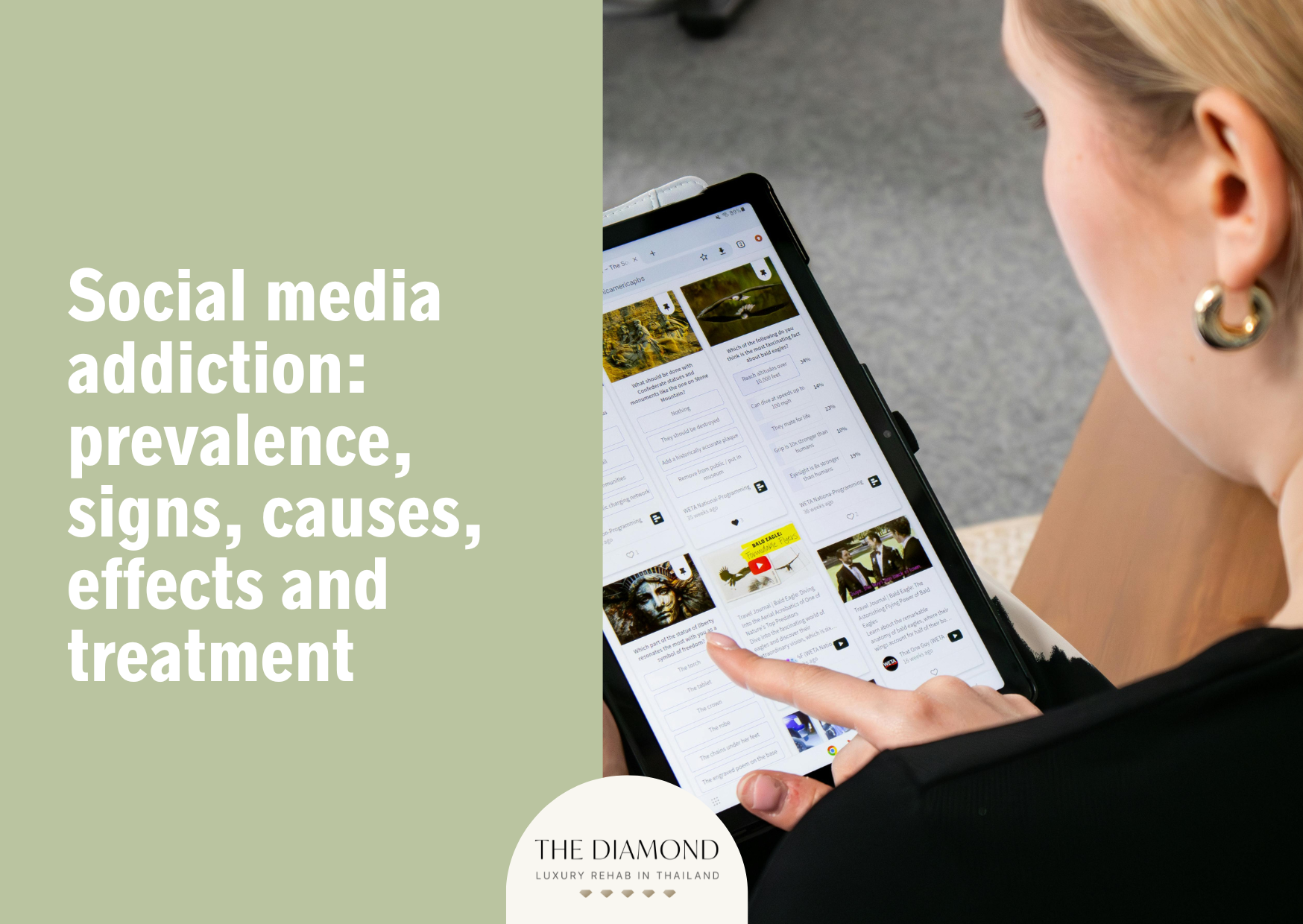
Social media addiction describes the excessive use of networking platforms, disrupting daily activities and personal well-being. An intense need to remain online often leads to ignored responsibilities and emotional strain.
The prevalence of social media addiction in the United States ranges from 5% to 15%, depending on how strictly the condition is defined. Stricter criteria identify about 5% as addicted, while more flexible definitions raise the estimate to as high as 15%.
The signs of social media addiction include excessive time spent online, preoccupation with social media, spending less time on hobbies and activities, neglecting time with others to stay online, secrecy around usage habits and defensiveness when questioned.
The causes of social media addiction are instant gratification, low self-esteem, loneliness and isolation, fear of missing out (FoMO) and algorithm-driven engagement.
The effects of social media are cyberbullying and harassment, sleep disruption, body image issues, decline in productivity, privacy concerns, increased anxiety and depression, reduced attention span and misinformation and fake news.
Treatments for social media addiction include cognitive behavioral therapy (CBT), motivational interviewing (MI), dialectical behavior therapy (DBT), inpatient treatment, group therapy and digital detox.
What is social media addiction?
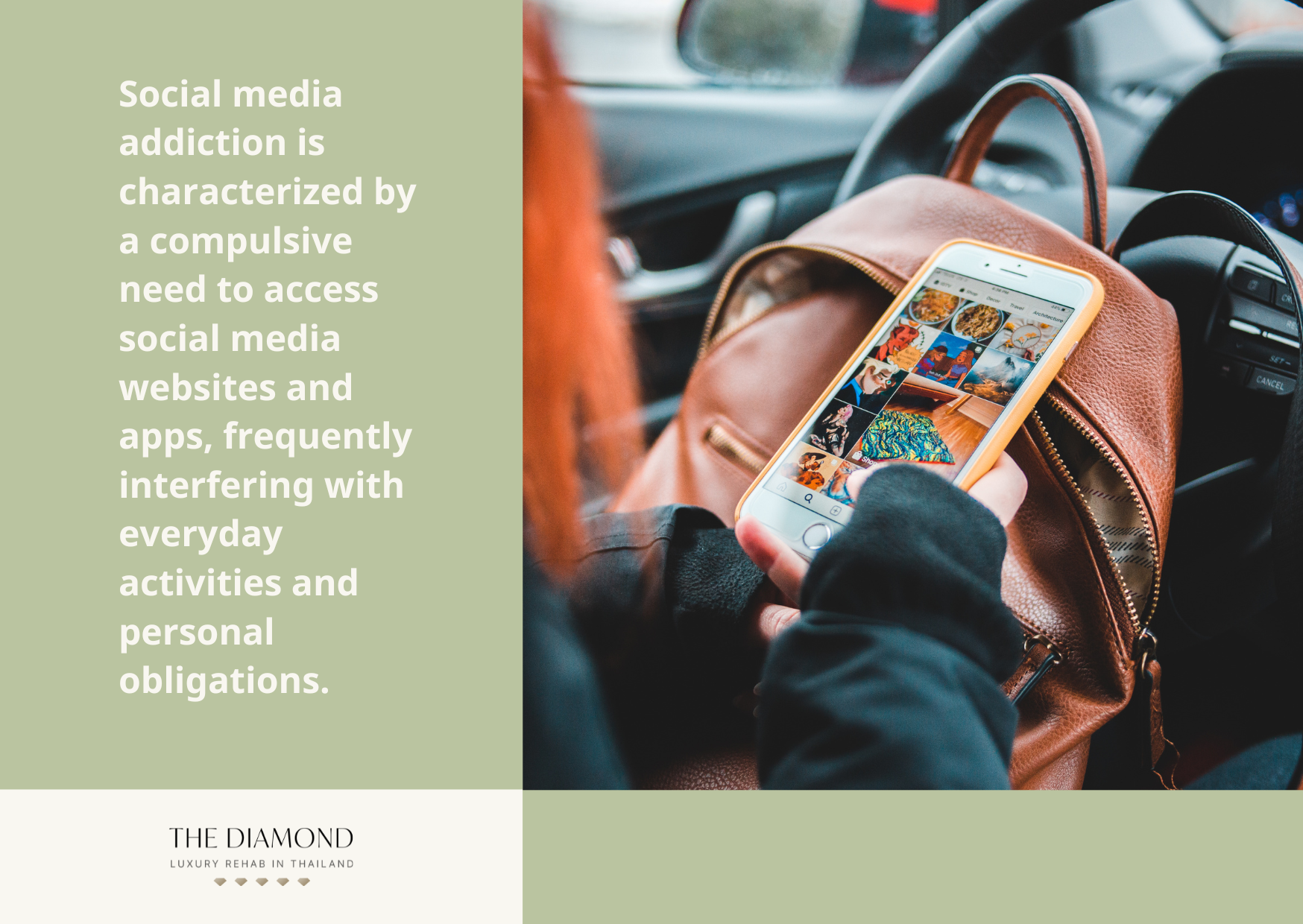
Social media addiction is characterized by a compulsive need to access social media websites and apps, frequently interfering with everyday activities and personal obligations. Numerous individuals struggle to regulate time spent online, overlooking harmful consequences in different aspects of life.
Frequent use of social media platforms is typically the first sign of the habit, before progressing into broader patterns of internet addiction. People suffering from problematic social media (SM) use feel compelled to check notifications, scroll through feeds or interact online, prioritizing virtual interactions over real-world experiences.
Over time, excessive reliance on digital interactions contributes to anxiety, depression and difficulty maintaining a balanced lifestyle.
Why is social media addictive?
Social media is addictive because it appeals to people’s need for approval. A single remark or like acts as an incentive, enticing users to come back. Interactions set off the brain’s reward pathway, resulting in short bursts of pleasure.
As users continue the cycle, the brain starts to associate social media with comfort and a sense of achievement. The release of dopamine during interactions deepens the attachment, making the experience feel rewarding even when the content lacks real value.
Users are kept in a state of constant anticipation by the unpredictable responses social media apps are designed to offer. Regular exposure to such stimuli alters normal brain chemistry, dulling the impact of everyday experiences. As the brain grows used to frequent immediate boosts, offline life starts to feel flat in comparison.
Is social media addiction real?
Yes, social media addiction is real. While the condition remains a topic of contention within the academic and scientific community as of writing, social media addiction demonstrates important traits of a behavioral addiction, including obsession, mood change, tolerance, withdrawal, conflict and relapse.
It is significant to note that The Diagnostic and Statistical Manual of Mental Disorders, 5th Edition (DSM-5, American Psychiatric Association, 2013) and the International Classification of Diseases, 11th Edition (ICD-11) do not recognize social media use disorder (SMUD) as a diagnosable condition, as noted in an April 2025 study by Tania Moretta and Elisa Wegmann, titled “Toward the classification of social media use disorder: Clinical characterization and proposed diagnostic criteria.”
However, as more scientific studies revealed clinically meaningful deficits linked to SM use, the disorder gained attention. Although DSM-5 criteria do not currently include social media addiction as an official diagnosis, the condition displays features commonly found in recognized behavioral addictions.
The lack of formal inclusion in diagnostic manuals has not prevented growing awareness of the problem among health practitioners. Whether excessive use is a reflection of personal habits or a deeper problem requiring intervention is still up for debate.
How common is social media addiction?
Between 5% and 15% of Americans are considered addicted to social media, contingent upon the severity level. The most stringent classification techniques, which necessitate the fulfilment of all symptoms, indicate approximately 5% of Americans are hooked to social media.
More lenient classifications (necessitating fewer symptoms) exhibit elevated prevalence rates, reaching as high as 15%, as per a 2021 report by Cheng et al., titled “Prevalence of social media addiction across 32 nations: Meta-analysis with subgroup analysis of classification schemes and cultural values.”
Due to variations in diagnostic standards and population samples, other studies have published conflicting figures on the prevalence of social media addiction (SMA) worldwide. The global prevalence of social media addiction among university students was determined to be 18.4%, as noted in a 2023 review by Salari et al., titled “The global prevalence of social media addiction among university students: a systematic review and meta-analysis.”
Asia exhibited the highest prevalence of social media addiction, with a rate of 22.8%. The prevalence in Europe was 12.4%. The incidence in Africa was 9.6%, and there was a 15.8% prevalence in the United States.
What are the signs of social media addiction?
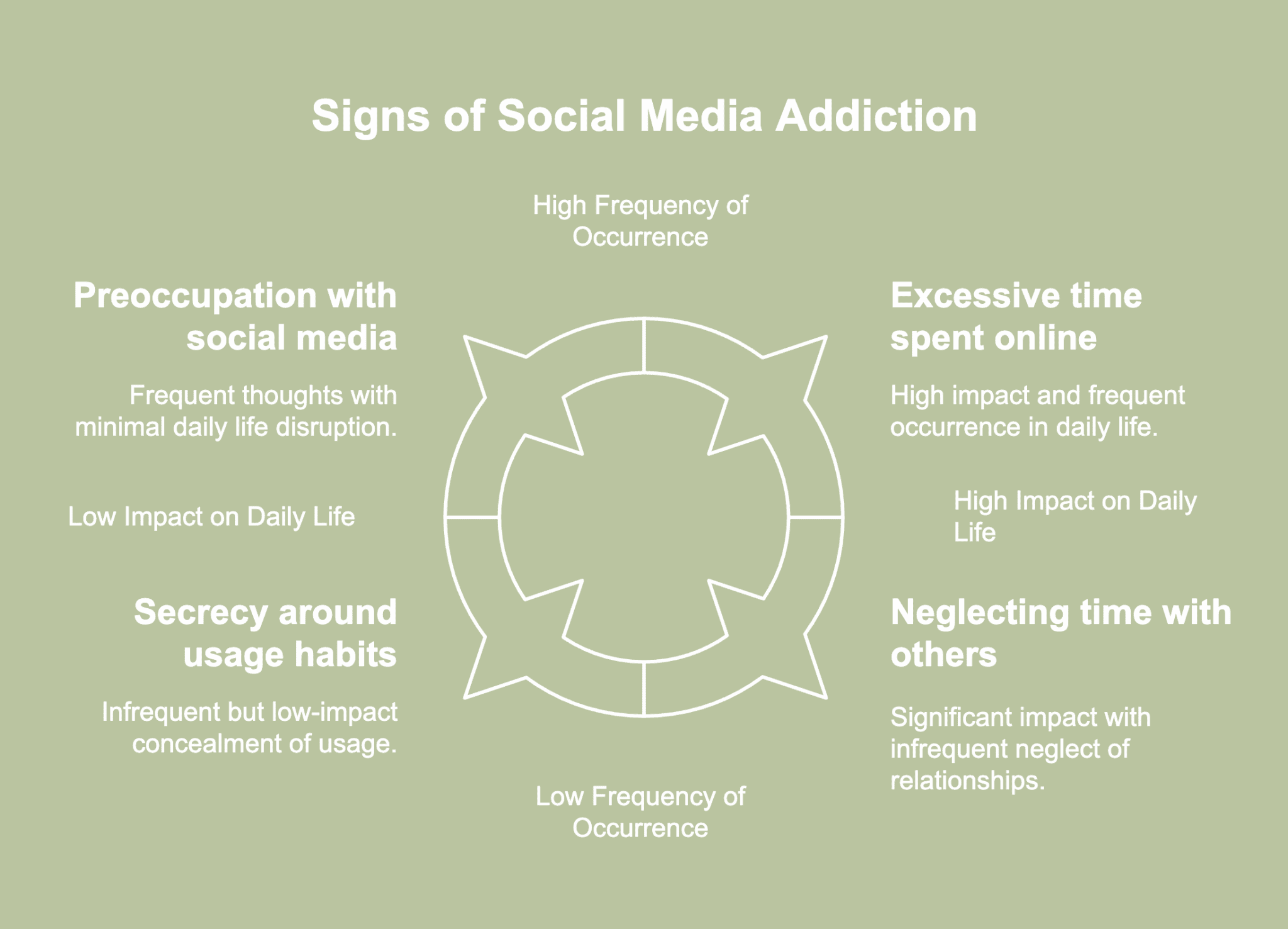
Signs of social media addiction are discernible patterns or behaviors pointing to excessive usage of social media, frequently at the expense of day-to-day functioning. The signs of social media addiction are listed below.
- Excessive time spent online: Individuals addicted to social media often spend hours online, far beyond casual use. A 2019 paper by Riehm et al., titled “Associations Between Time Spent Using Social Media and Internalizing and Externalizing Problems Among US Youth” mentioned the likelihood of comorbid internalizing and externalizing problems (e.g., emotional difficulties and behavioral issues) was higher among adolescents spending more time on social media.
- Preoccupation with social media: A social media addict continuously thinks about social media, even when not actively using platforms. An uncontrollable urge to check accounts frequently throughout the day leads to interruptions, sometimes occurring at inappropriate moments, such as during work or social gatherings. Preoccupation with online engagement disrupts focus, making concentration on real-world tasks difficult.
- Spending less time on hobbies and activities: Individuals overly reliant on social media often disregard hobbies, daily routines and close relationships, leading to difficulties in functioning, completing tasks and maintaining connections, as noted in a 2021 article by Satici et al., titled “Exploring the Association Between Social Media Addiction and Relationship Satisfaction: Psychological Distress as a Mediator.” As a result, such dependence increases the likelihood of experiencing poor physical and mental health.
- Neglecting time with others to stay online: SMA often causes individuals to prioritize online interactions over spending time with friends or family. Withdrawal from face-to-face communication occurs, with a preference for the comfort of digital engagement. Personal relationships tend to suffer as loved ones feel neglected or disconnected.
- Secrecy around usage habits: Individuals addicted to social media often conceal the amount of time spent scrolling or interacting online, especially when questioned by loved ones. Screens are tilted away, apps cleared from history or devices quickly switched off to avoid being noticed. The secretive pattern signals an internal awareness of the habit becoming excessive, yet the person remains unwilling to openly acknowledge the problem.
- Defensiveness when questioned: Concerns raised by others about digital habits often trigger immediate resistance, with responses downplaying the issue or framing questions as criticisms. Conversations aiming to express care or encourage change quickly turn tense, as the user attempts to justify continued engagement. The defensiveness stems from a fear of losing access to a coping mechanism, rather than from true disbelief in the concern.
How do you know if you have social media addiction?
To know if you have social media addiction, begin by observing how often you feel the need to check your phone, especially during situations requiring focus, rest or face-to-face interaction. Constant urges to stay connected, even in the middle of important tasks, are likely to suggest a loss of control.
If using social platforms has become the default response to boredom, stress or emotional discomfort, the behavior is likely to have shifted from habit to dependence. A social media addict often struggles to reduce usage, even once sleep, work or relationships begin to suffer as a result.
Feelings of frustration, anxiety or emptiness arise when access is limited and attempts to disconnect frequently fail despite good intentions. Online validation starts to feel necessary for emotional balance, while offline life begins to lose appeal. What once served as a tool for connection begins to dominate daily routines and mental focus.
What are the causes of social media addiction?
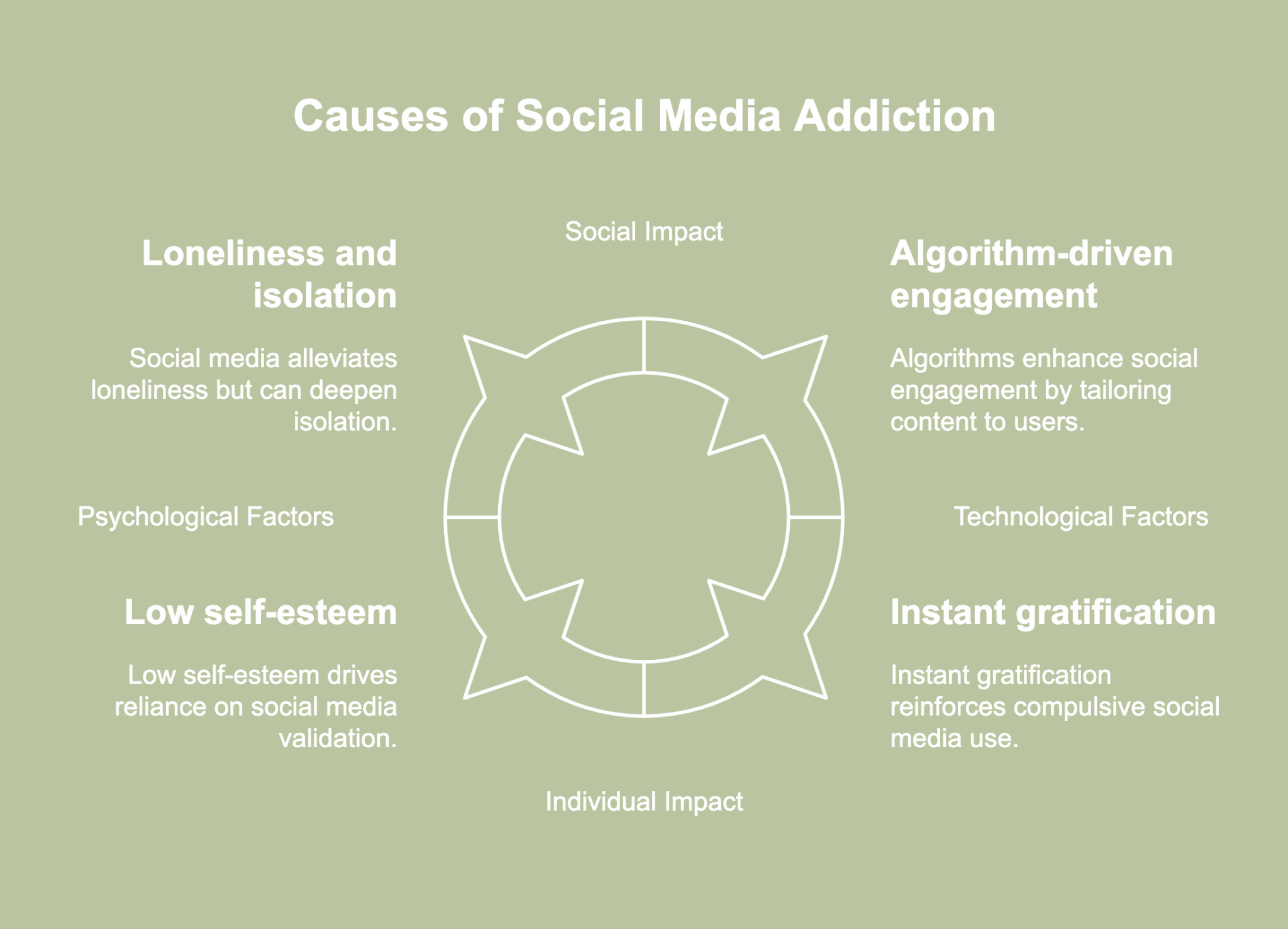
Causes of social media addiction denote the diverse elements leading to the emergence of compulsive and excessive engagement with social media platforms. The causes of social media addiction are listed below.
- Instant gratification: Social media offers immediate feedback through shares, comments and likes, producing feelings of satisfaction and reward. Instant gratification triggers the dopaminergic system in the brain, reinforcing the habit of continuously monitoring for updates. Especially on sites like Instagram and Snapchat, social media (SM) use depends much on one’s image and self-presentation.
- Low self-esteem: Individuals with low self-esteem are likely to turn to social media for reassurance and confidence-building through interactions with others. A 2017 study by Andreassen et al., titled “The relationship between addictive use of social media, narcissism, and self-esteem: Findings from a large national survey” revealed addictive social media behaviors were more common among individuals with low self-esteem, using the platform to address insecurities and boost self-image.
- Loneliness and isolation: One of the causes of addiction relates to how social networking platforms serve as a way to alleviate feelings of loneliness and social isolation for certain people. Social media websites provide a sense of connection with others, even if interactions remain superficial or virtual. Results of a 2023 study titled “Associations between social media use and loneliness in a cross-national population: do motives for social media use matter?” by Bonsaksen et al., found increased loneliness positively correlated with more time spent on social media. Even after controlling for variables such as age, work, relationship status and health concerns, the link persisted.
- Fear of Missing Out (FoMO): A lot of individuals check social media all the time due to a fear of missing out on significant events, trends or social updates. Anxiety arises from the desire to stay connected and informed about what others are doing. Over time, the constant need to stay updated leads to compulsive checking, further reinforcing the cycle of anxiety.
- Algorithm-driven engagement: Social media platforms use sophisticated algorithms to curate content tailored to each user’s preferences, making the experience highly engaging. Users are continuously exposed to content of interest or entertainment due to algorithms, encouraging return visits for more. With so much new stuff to consume all the time, the never-ending flow of tailored content encourages extended use.
Who is at risk of social media addiction?
People at risk of social media addiction include those experiencing impulsivity, individuals with anxiety and social anxiety, females, people prone to fixating on negative information, and individuals with low self-esteem, as noted in a 2022 paper by Zhao et al., titled “Risk Factors Associated With Social Media Addiction: An Exploratory Study.”
Individuals with a higher degree of impulsivity were more susceptible to developing a social media addiction. Impulsive individuals experience difficulty with self-regulation, resulting in an excessive use of social media.
Anxious individuals were additionally prone to addiction. Socially apprehensive individuals were more likely to engage in excessive SM use due to a preference for online communication over in-person interactions.
Another major predictor of social media addiction (SMA) was gender. Compared to men, women had a larger risk of developing SMA and showed higher rates of addiction.
Individuals concentrating on negative social media content exhibit a higher susceptibility to addiction, indicating the way adverse emotional processing contributes to addictive behaviors.
Lastly, reduced self-esteem was associated with increased levels of addiction. Individuals with diminished self-esteem utilize social media to obtain validation and evade real-life insecurities.
What are the effects of social media addiction?
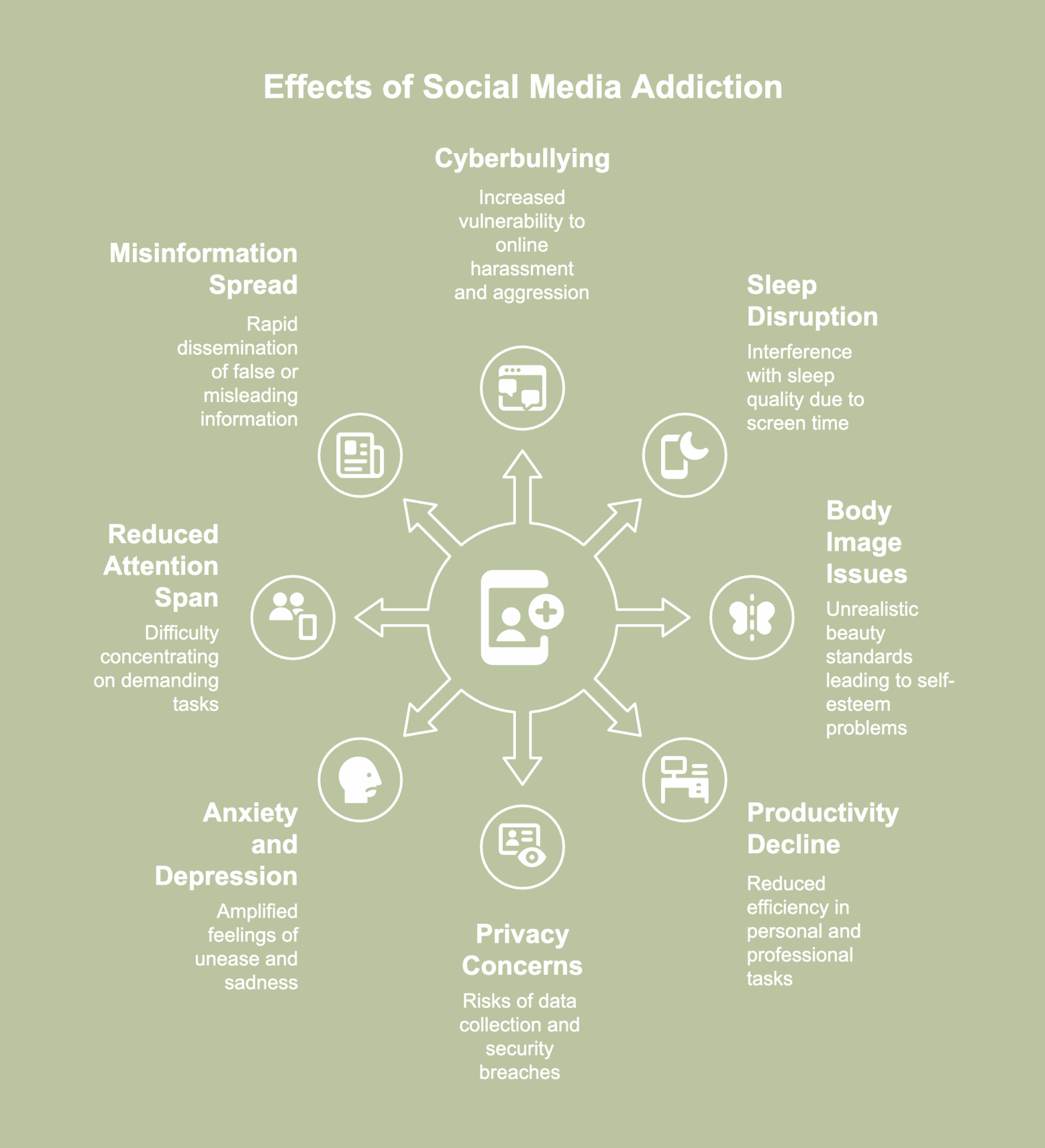
Effects of social media addiction describe the negative outcomes occurring when using social media becomes unmanageable. The effects of social media addiction are listed below.
- Cyberbullying and harassment: Social media platforms create an environment where users are vulnerable to cyberbullying, harassment or negative comments. The anonymity of online interactions often emboldens individuals to engage in aggressive behavior typically avoided in face-to-face communication. According to a 2023 study by Lee et al., titled “Cyberbullying, Social Media Addiction and Associations with Depression, Anxiety, and Stress among Medical Students in Malaysia,” out of 270 participants, 24.4% reported experiencing cyberbullying, and 13% admitted to engaging in such behavior within the previous six months. Over 80% of interviewees witnessed instances of cyberbullying.
- Sleep disruption: Spending excessive time on social media, particularly before bed, tends to interfere with sleep quality. The blue light emitted from screens interferes with the body’s production of melatonin, a hormone regulating sleep cycles. A 2021 paper by Pirdehghan et al., titled “Social Media Use and Sleep Disturbance among Adolescents: A Cross-Sectional Study” found that a higher level of social media use was correlated with poor sleep quality. Adolescents suffering from poor sleep quality spent an average of 36 minutes more on social media than their peers.
- Body image issues: Unrealistic ideals of beauty and success found on social networking sites often drive pressure to fit idealized images. Seeing polished representations promotes skewed self-perception and negative body image. Constant comparison with influencers and celebrities lower self-esteem, making personal achievements feel inadequate. Over time, striving for unattainable perfection contributes to anxiety, depression and unhealthy behaviors.
- Decline in productivity: Frequent SM use significantly reduces productivity in both personal and professional settings. The habit of constantly checking notifications or scrolling through feeds distracts individuals from concentrating on tasks. Such interruptions lead to procrastination, missed deadlines and lowered performance in academic or professional responsibilities.
- Privacy concerns: Social media platforms often collect vast amounts of personal data from users, raising significant privacy concerns. Platforms often track and share data like location, browsing habits or preferences, sometimes without full user awareness. Additionally, confidential information is likely to be used for targeted ads or fall into the hands of malicious actors, leading to identity theft or security breaches.
- Increased anxiety and depression: Social media tends to amplify feelings of anxiety and depression, especially when individuals compare personal experiences to the curated images presented by others online. Disruptive use of social networking sites (SNS) has been linked to mental health disorders including depression, anxiety, obsessive-compulsive disorder (OCD), attention deficit hyperactivity disorder (ADHD) and stress, according to a 2023 review article by Aviv M. Weinstein, titled “Problematic Social Networking Site use-effects on mental health and the brain.”
- Reduced attention span: Reduced attention span often develops as social media platforms encourage rapid shifts between images, videos and short bursts of text. Constant exposure to fast-paced content trains the brain to expect instant stimulation, reducing the ability to concentrate on more demanding tasks. Tasks requiring sustained concentration, such as reading or studying, begin to feel frustrating.
- Misinformation and fake news: The dissemination of false information and fake news via social media platforms has detrimental effects on public opinion and decision-making. The rapid, viral nature of social media allows misleading information to circulate widely before being fact-checked. As a result, detrimental ideologies or conspiracy theories spread, leading to confusion and a lack of trust in credible sources.
How does social media affect the brain?
Social media affects the brain by stimulating the reward system, resulting in impulsive behavior and impaired decision-making abilities, according to a 2023 paper by Mathura Shanmugasundaram and Arunkumar Tamilarasu, titled “The impact of digital technology, social media, and artificial intelligence on cognitive functions: a review.”
Additionally, social media induces modifications in the cognitive control regions of the brain, including the prefrontal cortex, resulting in diminished impulse control, emotional regulation, and working memory. The review noted how ongoing digital distractions interfere with memory, lower gray matter in areas responsible for storing information and disrupt focus.
A 2023 study by Maza et al., titled “Association of Habitual Checking Behaviors on Social Media With Longitudinal Functional Brain Development” identified a link between frequent use of social media platforms during early adolescence and changes in how the brain processes social feedback. Regular exposure appears to influence brain development related to social interaction, with the reward system playing a role in heightened sensitivity to digital responses.
Does social media cause depression?
No, social media does not cause depression. The relationship between social media and depression is complex, and while social media use contributes to and is linked with depression, saying social media directly causes depression is not accurate.
An abundance of research has established a correlation between heavy social media use and an uptick in depressive symptoms. For instance, adolescents demonstrating addictive tendencies towards social media had a higher likelihood of developing symptoms of depression, according to a 2023 review by Azem et al., titled “Social Media Use and Depression in Adolescents: A Scoping Review.”
The study further mentioned the problem of cyberbullying has been recognized as a substantial determinant of depression among adolescents. Depressive disorders are likely to develop over time as a result of factors like continuous comparison, seeking approval or absorbing negative content, especially for people already predisposed to mental health problems.
How does social media affect mental health?
Social media affects mental health by having beneficial as well as detrimental impacts on people’s feelings, actions and thought processes. Overuse results in disrupted, delayed sleep, diminishing overall well-being and adding to fatigue and concentration difficulties.
Negative self-esteem and aggravating mental health problems are the results of feelings of inadequacy and body dissatisfaction brought on by continual exposure to unrealistic standards of beauty.
The correlation between excessive use of social media and heightened levels of depression, anxiety and low self-esteem is mostly attributed to social comparison, cyberbullying and the expectation to uphold an idealized online public image.
While online interactions create a sense of belonging, over-reliance on virtual validation weakens real-world relationships and emotional resilience. Prolonged engagement with negative or harmful content exacerbates symptoms of mental illness.
What are the treatments for social media addiction?
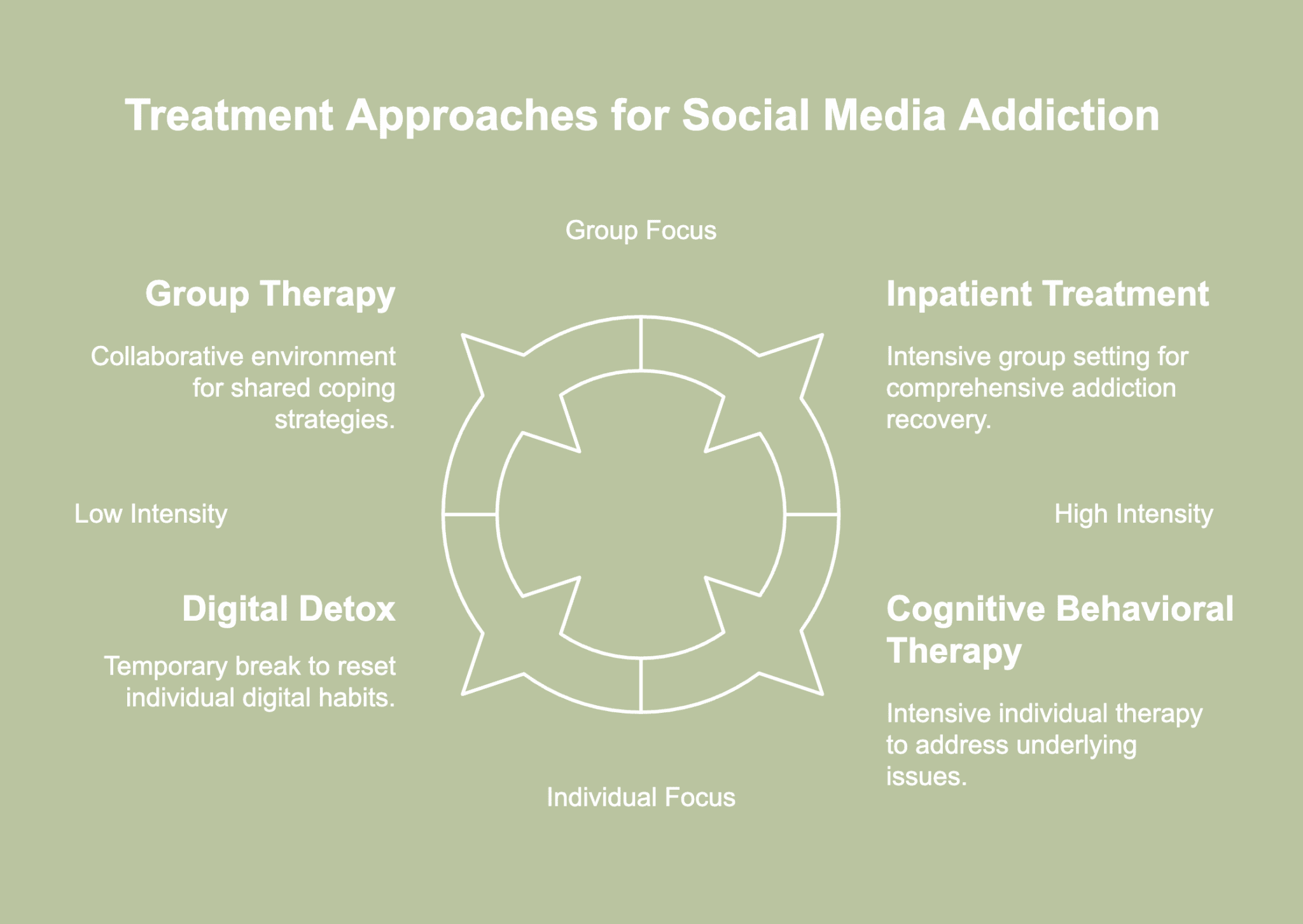
Treatments for social media addiction refer to structured methods used to help individuals regain control over compulsive platform use and restore balance in daily life. The most widely used treatments for social media addiction are listed below.
- Cognitive behavioral therapy (CBT): Through CBT, people identify triggers leading to excessive SM use and adopt healthier coping strategies. Therapists assist individuals in establishing realistic goals for reducing screen time and addressing underlying emotional concerns such as anxiety or low self-esteem. A 2023 article by Aviv M. Weinstein, titled “Problematic Social Networking Site use-effects on mental health and the brain” revealed a CBT-based short-term abstinence intervention program successfully treated 65 clients struggling with problematic social networking site use. The intervention had a beneficial impact on cognitive, behavioral, and affective function both during and after abstinence.
- Motivational interviewing (MI): Motivational interviewing helps with SMA by guiding individuals to explore personal reasons for change rather than imposing outside pressure. To raise consciousness of the effects of excessive usage on everyday life, the method employs reflective listening and open-ended inquiries. People start to identify internal conflicts, define goals and develop the drive to change behavior as a result of the process.
- Dialectical behavior therapy (DBT): DBT focuses on developing skills like mindfulness, emotional regulation, distress tolerance and interpersonal effectiveness to manage urges and negative emotions linked to compulsive social media use. A 2020 case report by Pluhar et al., titled “Adapting Dialectical Behavior Therapy for Treating Problematic Interactive Media Use” utilized DBT to treat a male patient, age 15, with a history of dysregulated internet use. During the course of 14 sessions covering 7 modules of DBT, the patient demonstrated improvement in his targeted self-regulation behaviors, such as cutting back on screen usage at night.
- Inpatient treatment: Inpatient treatment, often referred to as rehab, offers a more intensive approach, where individuals live at a facility for a designated period to focus on overcoming social media addiction. The program offers a controlled setting free from everyday distractions and triggers like social media access. Therapy, counseling and digital detox methods are frequently used in inpatient programs to treat the addiction as well as any underlying emotional problems.
- Group therapy: Under the guidance of a qualified therapist, group therapy provides an environment where individuals share personal stories and pick up coping mechanisms from one another. Individuals seeking therapy learn to set limits and develop positive internet habits. Regaining control over social media use is made easier by peer accountability and encouragement.
- Digital detox: A digital detox requires stepping away from all digital devices for a designated period. Breaks range from a single day to several weeks, depending on individual needs. Results of a 2020 study by El-Khoury et al., titled “Characteristics of social media ‘detoxification’ in university students” provided evidence on how students participating in social media detoxification experienced improved mood, reduced anxiety and better sleep both during and immediately after the process.
How to stop social media addiction?
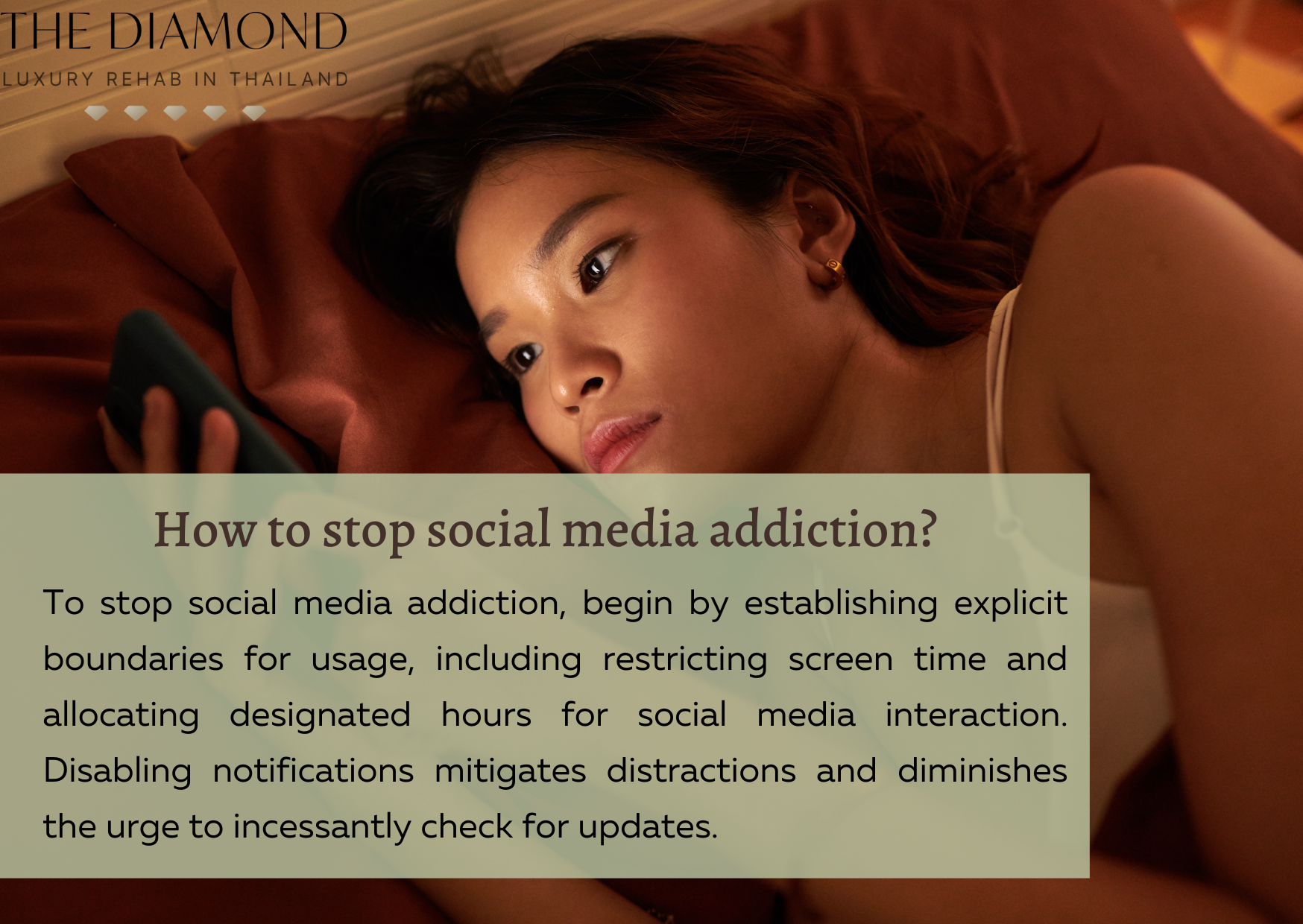
To stop social media addiction, begin by establishing explicit boundaries for usage, including restricting screen time and allocating designated hours for social media interaction. Disabling notifications mitigates distractions and diminishes the urge to incessantly check for updates.
Offline pursuits such as hobbies, physical activity or spending time with loved ones provide fulfilling substitutes for scrolling. Taking breaks, including a digital detox, allows for a mental reset and lessens reliance on web-based tools.
Recognizing emotional triggers like boredom or loneliness helps people cope without using social media. Seeking support from family, friends or a mental health professional offers guidance and accountability in the recovery process.

